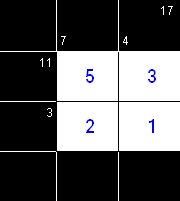
|
Kakuro - there are many ways to solve this puzzle, and many techniques that you can employ to help you along the way. Here we look at some kakuro solving strategies to help you on your way!
The best way to get your teeth into a kakuro puzzle is to look for the cells with the least potential valid combinations. Typically, runs composing of two cells or with low numbers - 3, 4 for instance will be good candidates.
For instance, 3 can only be 2, 1 or 1, 2 and 4 can only be 1, 3 or 3, 1 (remember that 2, 2 is not possible as you cannot repeat an integer within the confines of an individual run.

For instance, look at this portion of a kakuro puzzle below: you can see how the few potential combinations of the 4 and 3 can easily help you solve the puzzle, and limit the other combinations. For instance, 7 could normally be 6, 1 or 5, 2 or 4, 3 and hence 1, 6 or 2, 5 or 3, 4. However, we know that the '3' must be 2, 1 or 1, 2 and so therefore the 7 cannot be 4, 3 or 3, 4 - removing two combinations.
Where there is a crossover, look for a potential shared value. Thus, in the grid below, we see there is a crossover between the 3 and the 4 - that is, they share a cell. We know the combinations are 2, 1 for the 3 and 3, 1 for the 4. Well, the only number in common here is the 1, therefore the 1 must go in the bottom left cell, and the 3 is therefore 2, 1 and the 4 is 3, 1: this is written in below:

Once the 3 and 4 have been written in, we can place the 7 as 5, 2 with certainty as this is the only combination left.
By working a puzzle and finding all the valid combinations, and cross referencing correctly, you can solve most puzzles.
If you have played sudoku, you have probably written potential numbers for each cell in the corner of each cell - it is hard to keep track otherwise. Similarly you might like to do the same for kakuro. If you know a cell can only contain 3 or 6 for instance, then write this in the corner of the cell. Then use cross-elimiation of other runs to find out whether it must be a 3 or 6 and then place the digit with certainty. Remember to update your pencilmarks as you go through the puzzle else you can confuse yourself and even shoot yourself in the foot!
Over time, you will start to learn the combinations of valid digits that can be used to make up each number. For instance, to make 3 from 2 cells is easy: only 2, 1 or 1, 2. But what about making 9? There are many more combinations. Now try and make 20 from 5 cells and so on and so forth! The solution is to print a list of combinations out. Additionally, learn these Common kakuro combinations to help you out along the way!
Quick Links to other games, puzzles and quiz games for you at Saidwhat:
Sudoku | Sudoku CD | Kakuro | Celebrity Hangman | Quotes Quiz |